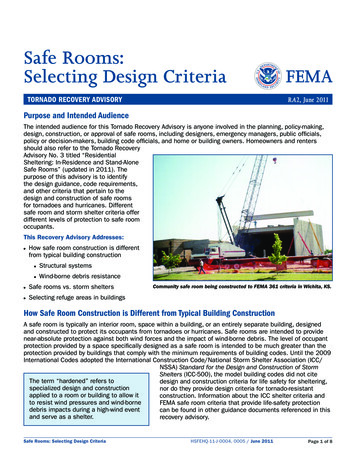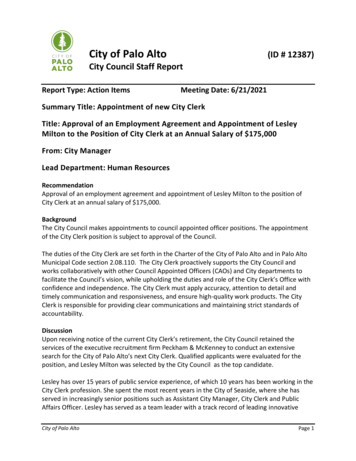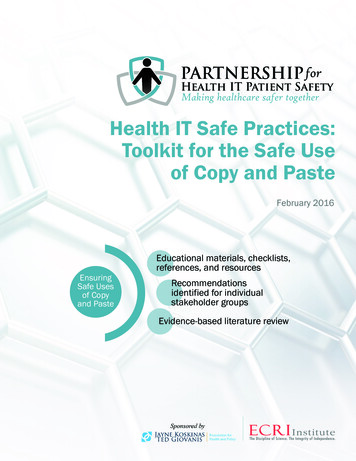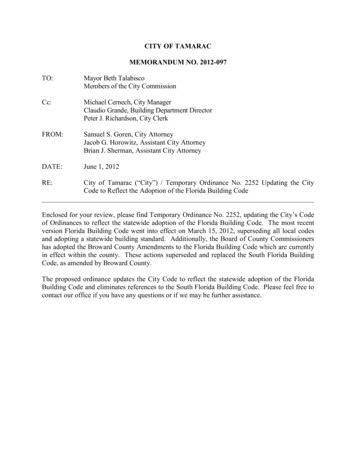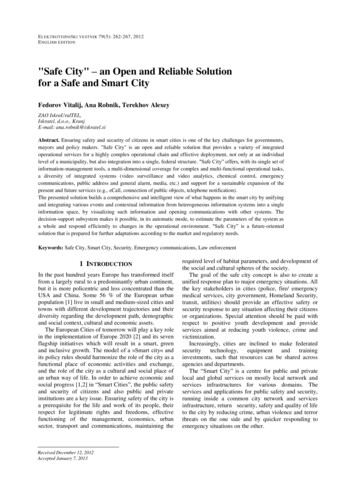
Transcription
E LEKTROTEHNIŠKI VESTNIK 79(5): 262-267, 2012E NGLISH EDITION"Safe City" – an Open and Reliable Solutionfor a Safe and Smart CityFedorov Vitalij, Ana Robnik, Terekhov AlexeyZAO IskraUralTEL,Iskratel, d.o.o., KranjE-mail: ana.robnik@iskratel.siAbstract. Ensuring safety and security of citizens in smart cities is one of the key challenges for governments,mayors and policy makers. "Safe City" is an open and reliable solution that provides a variety of integratedoperational services for a highly complex operational chain and effective deployment, not only at an individuallevel of a municipality, but also integration into a single, federal structure. "Safe City” offers, with its single set ofinformation-management tools, a multi-dimensional coverage for complex and multi-functional operational tasks,a diversity of integrated systems (video surveillance and video analytics, chemical control, emergencycommunications, public address and general alarm, media, etc.) and support for a sustainable expansion of thepresent and future services (e.g., eCall, connection of public objects, telephone notification).The presented solution builds a comprehensive and intelligent view of what happens in the smart city by unifyingand integrating various events and contextual information from heterogeneous information systems into a singleinformation space, by visualizing such information and opening communications with other systems. Thedecision-support subsystem makes it possible, in its automatic mode, to estimate the parameters of the system asa whole and respond efficiently to changes in the operational environment. "Safe City” is a future-orientedsolution that is prepared for further adaptations according to the market and regulatory needs.Keywords: Safe City, Smart City, Security, Emergency communications, Law enforcement1 INTRODUCTIONIn the past hundred years Europe has transformed itselffrom a largely rural to a predominantly urban continent,but it is more policentric and less concentrated than theUSA and China. Some 56 % of the European urbanpopulation [1] live in small and medium-sized cities andtowns with different development trajectories and theirdiversity regarding the development path, demographicand social context, cultural and economic assets.The European Cities of tomorrow will play a key rolein the implementation of Europe 2020 [2] and its sevenflagship initiatives which will result in a smart, greenand inclusive growth. The model of a »Smart city« andits policy rules should harmonize the role of the city as afunctional place of economic activities and exchange,and the role of the city as a cultural and social place ofan urban way of life. In order to achieve economic andsocial progress [1,2] in “Smart Cities”, the public safetyand security of citizens and also public and privateinstitutions are a key issue. Ensuring safety of the city isa prerequisite for the life and work of its people, theirrespect for legitimate rights and freedoms, effectivefunctioning of the management, economics, urbansector, transport and communications, maintaining theReceived December 12, 2012Accepted January 7, 2013required level of habitat parameters, and development ofthe social and cultural spheres of the society.The goal of the safe city concept is also to create aunified response plan to major emergency situations. Allthe key stakeholders in cities (police, fire/ emergencymedical services, city government, Homeland Security,transit, utilities) should provide an effective safety orsecurity response to any situation affecting their citizensor organizations. Special attention should be paid withrespect to positive youth development and provideservices aimed at reducing youth violence, crime andvictimization.Increasingly, cities are inclined to make vestments, such that resources can be shared acrossagencies and departments.The “Smart City” is a centre for public and privatelocal and global services on mostly local network andservices infrastructures for various domains. Theservices and applications for public safety and security,running inside a common city network and servicesinfrastructure, return security, safety and quality of lifeto the city by reducing crime, urban violence and terrorthreats on the one side and by quicker responding toemergency situations on the other.
"SAFE CITY" – AN OPEN AND RELIABLE SOLUTION FOR A SAFE AND SMART CITYLocal orientation, in conjunction with the national,cross-border and trans-national cooperation amongcities, is of great importance. Therefore, the relevantgovernance level may vary from the local to the federallevel and can also be a combination of several tiers.According to the documents and reports [3], a bigchallenge is to harmonize the programmes for the safecity at various levels and find appropriate solutions.The “Safe City” as a concept and solution offersinformation and communication services, combiningsecurity systems into a single information space basedon the cloud paradigm. Based on the ICT technologiesand paradigms (e.g., broadband infrastructure, fixedmobile convergence, the internet of things (IoT), cloudcomputing, big data), the ICT sector will help increasethe safety and social maturity level of the whole society,thus making its contribution to a more sustainablefuture.Based on the today’s implementations andexperiences, the concept of the "Safe City" offers largescale deployments of video-surveillance systems andemergency communications systems, but lacks a singleand universally accepted concept at all levels which arealso interconnected. The current approaches vary fromcity to city and bring very specific solutions whichcannot be easily integrated at the higher levels.Therefore, a novel approach to overcoming thesedeficiencies is needed.2 THE SOLUTION TERMED “SAFE CITY”The Iskratel Group has a long tradition and richexperiences in telecommunications solutions. Amongothers, it provides telecommunications solutions forcorporate and special networks together with thesupport for the security services and the 112 service (theemergency phone number). Based on its knowledge andcompetences of building security for metropolitan areasin the past and after thorough consideration of this area,Iskratel and IskraUralTEL have come to the conclusionthat the right solution is a comprehensive and wellconsidered approach that covers all the functional,topological and hierarchical, organizational, legislationand regulation aspects. This solution is termed “SafeCity” and its key characteristics are openness andreliability. It also supports smart integration of servicesfor safety and security at the city level into the federalinfrastructure. By using this approach, the localcharacteristics and global trends are equally importantand slightly differ on our markets (i.e., the Europeanmarket and the market of the Common IndependentCountries - CIS, especially Russia).In such a paradigm, cities and federal authoritiesshould not install hundreds of useless cameras "at everylevel" in order to demonstrate to citizens that the "bigbrother" vigilantly watches them, but first of all theyshould: make a list of social and urban areas that areself-sufficient with respect to organizationaland technical safety for urban sites. This kind263of facilities can be: "Safe School /Kindergarten", "Safe clinic / hospital", "Safebus / tram", "Safe Park / Square", "Safe road /parking", "Safe bus station / railway stations /airport", "Safe mall/ market", "Safe waterutility / boiler room", "Safe plant/ enterprise"and others, depending on the development ofthe infrastructure in a city, enforce mandatory requirements for the abovementioned facilities in the plan (at the local/municipal/ federal levels) including Mandatory minimum standard for each "safefacility" monitored by asecurity staff to detectthreats, localize the facility and arrive at it evenbefore the police forces, Mandatory minimum standard for equipmentof each "safe facility" providing physical andinformation security and its monitoring (itsequipment depends on the facility), Common city interfaces / protocols of physicaland information security, telecommunicationand communication systems that allow thesafety and security services of these facilitiesto receive (monitor) and share information atall the levels of the hierarchy of the "Safe City"internally and with the mission-critical centresof the city/ territory.To provide a large-scale centralized system for all theabove-mentioned areas in one step is unrealistic; thereare usually big problems with the budget as well as withappropriately trained and experienced staff. As a result,there are very often autonomous non-interoperablesystems introduced each essentially solving more or lessprivate, local problems.Weak elaboration on the operational needs forinstalling video cameras and/or other sensors leads to anaccumulation of a large amount of absolutelyunnecessary video and audio information which resultsin huge time and costs inefficiency in creation,implementation and operation of such systems.The city authorities develop and introduce in entralized urban systems like 911/112, alarm,notification and evacuation systems and securetelecommunication/communication systems. Thesesystems altogether incorporate centrally managed areasof life of an urban environment such as: City management and its administration, Law enforcement and its support for policyfeatures, Civil defence and emergency situations(including environmental monitoring), Medical services management, Public transport management, Housing and utility services, Other urban structures (depending on thedevelopment of the city infrastructure).
264VITALIJ, ROBNIK, ALEXEYThe solution “Safe City”, a common work betweenIskratel and IskraUralTEL, offers the best answers to allthe above-mentioned requirements and expectationsbased on a step-by-step approach fully supporting phaseimplementation.The figure below illustrates the various interrelationships among the different layers of thetechnology stack of the “Safe City” solution, these are: Secured network infrastructure and integrationsources, Infrastructure as a Service and Platform as aService for the “Safe City” services in a cloud, Information space including federated data,system enablers, services logic and enablers forvisualisation API for openness towards various services andapplications at the regional and federal levels.Figure 1: The “Safe City” technology stackOn the top of this stack, applications and new servicescan be built by various stakeholders for consumers,public organizations or businesses.3 “SAFE CITY” – A SOLUTION FORINTEGRATED SYSTEMS ANDAPPLICATIONSThe open and reliable “Safe City” solution consists ofthe following functional systems and features: Intelligent video surveillance / local videosurveillance systems, Emergency communication / local securitysystems, Public address, general alarm / localnotification systems, Environmental monitoring and forecasting/local fire and chemical control systems, Spotting, position location / eCall, ERAGLONASS services, Communications and mass media.Figure 2: The “Safe City” solution and its featuresMost safe-city projects start with a video-surveillancesystem used to monitor the traffic / transport, publicplaces, areas of criminal activity, social facilities andfacilities of the residential sector. The intelligence insidethe video analytics brings added-value to the completesolution, including face recognition, shape detection andvehicle-plate numbers. The video analytics enablesconnectivity of additional systems into the platform(e.g., malls, hospitals, schools, factories, railwaystations).Video surveillance can be used by residential andbusiness users. Using this service, the public and privatesafety is guaranteed to a greater extent. Firstly, itincreases the efficiency of the system by increasing thenumber of potential operators. Secondly, it allows theresidents to self-monitor various situations at home in atrusted and secure way.The emergency communication system supports theorganization of the information and emergencyterminals in public places and also a close relationshipwith the local security service. The “Safe City” solutiontakes into account the specifics of the incorporatedfacilities, which require special realisation, such asbeing vandal- or explosion-proof. For personal safety,the integration and positioning of a mobile alarm devicefor the elderly or disabled people, is of greatimportance.The E112 service is one of the services of theemergency communications. The Service eCall inEurope and ERA-GLONASS in Russia are additionalservices based on the existing E112 service. The firstuses GPS and the latter GLONASS satellites. Theymeet the European and Russian standards and alsorespect the national and local specificities in terms ofemergency services. Vehicles equipped with the eCalland ERA-GLONASS system compliably with the InVehicle Systems (GPS/GLONASS, GSM modem) sendthe “minimal set of data” via a cellular network to theeCall subsystem as a part of the “Safe City” solution,which sends it further to the relevant services (e.g.,Public Safety Answering Point). This data can also beused for other commercial purposes.The public address system offers publicannouncements and general alarm signals. The “SafeCity” solution supplements it with additional featureslike telephony, SMS or mass media notifications. Thesolution can integrate various local public address
"SAFE CITY" – AN OPEN AND RELIABLE SOLUTION FOR A SAFE AND SMART CITYsystems in different organizations (e.g., malls, hospitals,schools, factories, railway stations) compliably with theapplicable regulations.The public-address system interoperates via the “SafeCity” solution with the fire-alarm systems thusproviding a more reliable and faster response andconsequently minimizing the potential damage.The “Safe City” solution provides the ability toconnect chemical sensors in order to control the highrisk production and mass-visited public areas. The fireand chemical control data together with meteorological,environmental and flood data give a complete picture ofthe situation.The mass media are today one of the main channelsof information. Ensuring full interaction with the massmedia (e.g. television, radio) is one of the functions ofthe "Safe city" platform. Providing information with orwithout moderating and ensuring the transmission of thecontent is just one of the many required features today.All the above-mentioned subsystems and features areinter-connected with each other and with the externalworld via a secured data network by using thesouthbound interfaces called adapters and thenorthbound interfaces called APIs.The adaptersintegrate various sources of data (e.g. legacy equipment,automation controllers, sensors, detectors, measuringelements) into a common information space. In mostcases, there is a one-way communication from thesource to the information space, but there also existsome special cases needing two-way communication.The core features used by all subsystems of any“Safe City” solution are called enablers. We distinguishtwo types of the enablers, the functional enablers andthe common system enablers. Both are presented in thefigure below.265The Access Policy and Rights Management grantauthorized users the right to use a service dynamically,while preventing access to non-authorized users. Thedata is protected using various mechanisms and isaccessed and exchanged in a secure manner. Since allkinds of users are an integral part of the secure andtrusted “Safe City” solution, technological elements bythemselves are not sufficient in guaranteeing a highdegree of trust and security. The complete solution mustalso comply with the applicable legal and socialregulations.Besides the functional enablers there is also a set ofcommon system enablers closely connected withexchanging a huge number of events and large amountsof simple text data in addition to the complexmultimedia and web data. These data are usually storedin databases. Therefore, the Event and DataManagement Enablers are the core enablers andarchitectural components.New technologies, new forms of storing andaccessing data, and the ability to retrieve informationfrom different data sources are a part of the “Safe City”solution (data federation).Analysing large amounts of data in real time requiresnew techniques. Using statistics, semantic techniques,machine learning and logical reasoning methodssemantically enrich the data to be employed. Byanalyzing data streams, texts, video and web data, thesimple and advanced analysis is made.Correlating the current data with its history, theprognosis enabler can predict the future events andcircumstances based on existing information. Tounderstand the circumstances and interpret informationin an easier way, the decision-making systems have alsobeen made a part of the “Safe City” solution.The Service Oriented Architecture (SOA) principlesand their key elements, i.e. the Enterprise Service Bus(ESB) and integration bus, are the basis for a modularapproach to software development, enabling us to buildinformation interaction in heterogeneous environmentsbased on components with standardized interfaces andprotocols. These technological concepts allow us tointegrate various systems in a secure and efficient way.4 “SAFE CITY” AND ITS CORECONFIGURATIONFigure 3: The “Safe City” solution – enablers and sources ofinformationAs the “Safe City” solution serves multiple clients (e.g.,customers, public organizations, enterprises, etc.)sharing the same sources, the multi-tenancy paradigm isrespected in each of the below areas: Access policy, Data protection and accessibility, Secured Data Network.The “Safe City” solution in its typical configurationincludes the following subsystems: Urban intelligent video system covering publicplaces, busy intersections, areas of inter-cityroutes, schools and hospitals of the city andincluding a commercial video-surveillancesystem (e.g., shopping malls, gas stations, etc.), GIS monitoring of mobile facilities (electroniccity map), Emergency "citizen-police", Video recording of traffic violations "Administrative practice",
266VITALIJ, ROBNIK, ALEXEY Searching for lost and stolen vehicles anddetecting them, Intelligent searching and advanced analytics onbig data, Management centres for squads and patrolscombining the advantages of the other systems.Using the advantages of the modern techniques duringthe design phase of subsystems of the "Safe City"solution ensures performances and functionalenhancements.The sophisticated structure of the core modules ofthis solution allows deploying the data centre andconnects a variety of automated safety area subsystemsinto a single information space efficiently.Besides the core subsystems, the platform can alsoinclude a specific subsystem such as: Security system of housing facilities; Monitoring and forecasting of emergencysituations; Monitoring of environmental state of a region; Unified process and storage for medicalinformation for residential users.The core architectural components and featuresintegrating such a subsystem in a unique solution are: Broadbandnetworkusingvarioustechnologies, Data federation and common informationspace, Data protection, Data centres and archives, High-speed multi-service bus for exchangingbig data, Basic and advanced analytics for big data.The user rights and trust are essential in such a complexsolution. For various users to access the subsystems anddata, specialized centres for monitoring and control aredeveloped. They communicate with the “Safe City”platform using APIs and exchange data and informationthrough a multi-service network. The most prominentcentres are: Squads and patrols control the centre at the citypolice department with an electronic map ofthe city, access to video-surveillance and firealarm systems, and emergency communicationsystems; Traffic-situation monitoring centre for trafficpolice; Emergency control centres for civil defence,fire and rescue departments; Emergency monitoring centres and naturaldisaster response centres; Regional medical information centre with acommon medical base of the resident; Traffic information-analytical centre at the citypolice department for insurance companies.5 FUTURE ORIENTATIONThe open interoperable architecture of the “Safe City”solution guarantees an easy-to-upgrade and future-safelong-term solution which can fulfil all the strongrequirements regarding safety, trust and security,interoperability, openness and excellent user experience.At Iskratel and IskraUralTEL we will tailor andfunctionally enrich our solution according to thecustomers’ and markets’ demands.In order to make the services of the “Safe City”solution as efficient and reliable as possible, we willsupport the whole chain of handling the safety areas,mentioned in the first section, in a most efficient wayusing the following steps: Planning of the specific safety area, Modelling the area, Analysing the area, Maximally reducing the probability of adisaster, Emergency response, Damage assessment.The decision-support subsystem mentioned above willassess in its automatic mode the parameters of each areaas a whole and will respond efficiently to changes in theoperational environment.6 CONCLUSIONSThe “Safe City” solution builds a comprehensive andintelligent view on safety in the smart city in a trustedway. It unifies and integrates various events andcontextual information obtained from heterogeneousinformation systems into a single information space, byvisualizing such information and opening it to othersystems.The biggest competitive advantage of our solution isits openness, reliability and ability for “easy-tointegrate” new features and new sources of information.The highly skilled experts of IskraUralTEL bring withtheir expertise in the local Russian specifics and withtheir deep domain knowledge an additional added-valueto our solution.ACKNOWLEDGMENTSThe authors would like to thank their colleagues forhelping them prepare this work and for valuablecomments and thorough reading of this paper.REFERENCES[1][2][3][4]European Commission, Directorate General for RegionalPolicy, Cities of tomorrow: Challenges, visions, c.europa.eu/information munication-en.pdf.European project “SafeCity”, www.fi-ppp.eu/projects/safecity/ and its publicly available documentationDocumentation of Iskratel's solution “Safe City”
"SAFE CITY" – AN OPEN AND RELIABLE SOLUTION FOR A SAFE AND SMART CITYFedorov Vitalij graduated from the Faculty of SystemEngineering and Robotics of Novocherkassk Polytechnicalinstitute in 1993 and from the Moscow Bank School of theBank of Russia in 1996. From 1993 to 2004 he took a numberof technical positions in the system of the Bank of Russia.From 2004 to 2006 he headed a design department of the FSBKrasnodar branch NTTs Federal State Unitary Enterprise"Atlas" of Russia, and from 2006 to 2012 he has been CTO inthe JSC “Orbita” (Krasnodar) company. As a project chiefengineer he has been involved with several telecommunicationand infrastructure projects, among them the projects of powerstructures in the Southern Federal District of and in therepublics of Transcaucasia: Abkhazia – South Ossetia and theproject for the MTS and MEGAPHONE communicationsservice providers.Ana Robnik graduated in 1985 in applied mathematics fromthe Faculty of Mathematics, Physics and Mechanics,University of Ljubljana, Slovenia. In 1989 she received hermaster's degree in computer science from the Faculty ofComputer and Information Science of the same university. Shehas been employed with Iskratel for 20 years. She started hercareer in 1993 in the IT department and then joined adepartment developing the SI2000, and later the SI3000. Laterand until 2009 she worked as a head of a departmentdeveloping a system to manage and monitor network elementsof the Iskratel portfolio. During the past two years she hasbeen working as a telecommunications consultant. She leads aresearch group at Iskratel, coordinates work in standardizationorganizations, and is active in the Telemanagement Forum.Alexey Terekhov graduated in 2001 in CommunicationNetworks and Telecommunications Equipment from thePovolzhskaya State Academy of Telecommunications andInformatics. From mid-2001 to 2003 he worked in thetechnical and sales departments of Iskratel Slovenia. In 2004he joined Iskrateling where he worked as a system engineer, in2006-2008he held the position of a Senior TechnicalConsultant, and from 2008-2010 he was a Deputy TechnicalDirector. From the middle of2010 he has been working as aSolution Manager for Corporate Networks at IskratelSlovenia.267
According to the documents and reports [3], a big challenge is to harmonize the programmes for the safe city at various levels and find appropriate solutions. The "Safe City" as a concept and solution offers information and communication services, combining security systems into a single information space based
